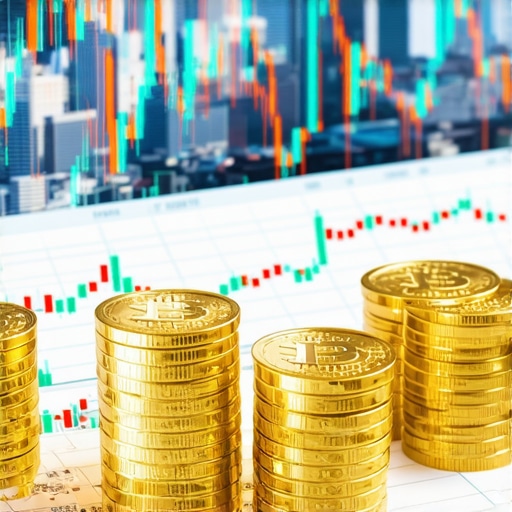The Influence of Global Events on Gold Prices
Gold has long been regarded as a safe haven asset, especially during turbulent times. The impact of global events on gold prices is significant, with various factors such as geopolitical tensions, economic instability, and shifts in market sentiment playing crucial roles in shaping its value. Understanding how these events influence gold prices is essential for investors looking to navigate the complex landscape of gold investment.
Geopolitical Tensions and Their Effects on the Gold Market
Geopolitical events, such as conflicts, wars, and political unrest, often lead to increased demand for gold. Investors tend to flock to gold as a protective measure against uncertainties, driving prices upward. For example, during crises like the Iraq War or tensions in the Korean Peninsula, gold prices saw notable spikes as investors sought to safeguard their wealth. This phenomenon underscores gold’s role as a hedge against geopolitical instability.
Economic Instability and Inflation Concerns
Economic downturns and fears of inflation also significantly impact gold prices. When economies face challenges, such as recessions or rising inflation rates, investors often turn to gold to preserve their purchasing power. Historically, during periods of economic uncertainty, gold prices have surged as confidence in fiat currencies wanes. The relationship between gold and inflation is crucial for investors to comprehend, as understanding this can inform their investment strategies.
Market Sentiment and Speculation
The psychology of investors plays a vital role in the fluctuations of gold prices. If market sentiment shifts due to news events, speculation can lead to rapid changes in gold prices. Investors’ reactions to news reports regarding global economic conditions, interest rates, and central bank policies can create volatility in the gold market. For instance, announcements from the Federal Reserve regarding interest rate changes can substantially impact gold prices. When rates are low, gold becomes more attractive as an investment, leading to increased demand and higher prices.
Additionally, understanding gold demand trends is essential for recognizing how market sentiment can pivot. Awareness of how external events influence investor behavior can help individuals make informed decisions when investing in gold.
Conclusion: The Importance of Staying Informed
In conclusion, the impact of global events on gold prices is multifaceted, influenced by geopolitical tensions, economic instability, and market sentiment. For investors looking to maximize their returns and minimize risks, staying informed about these factors is crucial. By understanding the dynamics behind gold price fluctuations, investors can better position themselves in the ever-changing landscape of gold investment.
Analyzing Gold Supply and Demand Dynamics
The interplay of supply and demand is a fundamental aspect that influences gold prices. When evaluating gold investments, it’s crucial to understand how various factors affect supply and demand dynamics. For instance, increased mining production can lead to a surplus of gold in the market, potentially driving prices down. Conversely, a decrease in production or unexpected supply chain disruptions can lead to tighter supply, causing prices to rise. Investors should keep an eye on gold supply trends to make informed decisions.
The Role of Central Banks in Gold Markets
Central banks play a significant role in the gold market through their buying and selling actions. When central banks increase their gold reserves, it can signal confidence in gold as a safe-haven asset, which often leads to price increases. For example, recent trends in central bank purchases have illustrated a growing interest in gold as a strategy for diversifying reserves. Understanding the impact of central bank actions on gold prices can provide investors with insights into market trends and potential price movements.
Global Economic Indicators That Affect Gold Prices
Various economic indicators significantly impact gold prices. Key metrics such as inflation rates, unemployment figures, and GDP growth play a vital role in shaping investor sentiment towards gold. For instance, rising inflation often results in increased demand for gold as a hedge, driving prices higher. Investors should familiarize themselves with how to interpret these economic indicators and their implications for gold price trends. By analyzing these factors, investors can strategically position themselves to benefit from potential price fluctuations.
Impact of Currency Strength on Gold Valuation
The strength of the US dollar is another crucial factor affecting gold prices. Generally, when the dollar weakens, gold becomes more attractive to investors in other currencies, leading to increased demand and higher prices. Conversely, a strong dollar can have the opposite effect, making gold less appealing. Understanding the relationship between currency fluctuations and gold valuation is essential for investors aiming to optimize their portfolios.
Technological Advances in Gold Mining
Technological innovations in gold mining can also influence supply dynamics. Advances in extraction techniques and mining technology can lead to more efficient production, increasing the available supply of gold. However, these advancements can also result in environmental concerns and regulatory challenges, which may impact production costs. Investors should stay informed about developments in mining technologies and their potential effects on gold mining stocks, as these factors can directly impact overall market conditions.
Conclusion: The Importance of Holistic Market Understanding
In summary, understanding the various factors influencing gold prices is imperative for making informed investment decisions. From global events and economic indicators to technological advances and central bank actions, each element plays a role in shaping the gold market. By staying informed about these dynamics, investors can better navigate the complexities of gold investment and position themselves for success in an ever-evolving market.
Investment Strategies for Gold: Maximizing Your Potential
When it comes to investing in gold, having a clear strategy is essential. There are various gold investment techniques that can help you maximize your potential returns. Whether you’re considering physical gold like bars and coins, or securities such as gold ETFs, understanding the nuances of each option is critical. By diversifying your investments, you can mitigate risks while capitalizing on the unique benefits that each gold asset class offers.
Exploring Different Gold Investment Vehicles
Investors have several avenues to explore when it comes to gold investments. Popular options include gold bullion, gold mining stocks, and gold mutual funds. Each of these vehicles has its own risk profile, cost structure, and potential returns. For instance, gold bullion tends to be a more stable investment, while stocks of gold mining companies can fluctuate based on operational efficiency and market conditions.
Market Timing and Its Impact on Gold Investments
Another critical factor to consider in gold investment is market timing. Understanding gold price trends and market cycles can help you make informed decisions about when to buy or sell. Timing your investments correctly can make a significant difference in your overall returns. For example, purchasing gold during a market dip can yield better returns when prices rebound. Therefore, keeping abreast of market news and economic indicators is vital for investors.
Risk Management Techniques for Gold Investors
Effective risk management is crucial for any investment strategy, including gold. Investors should consider implementing strategies such as setting stop-loss orders or utilizing options to protect their investments. Additionally, regularly reviewing your gold portfolio and adjusting your holdings based on market conditions can help mitigate potential losses. This proactive approach is essential for navigating the often volatile nature of gold markets.
The Importance of Research and Education
Before diving into gold investments, educating yourself about the market is indispensable. Resources such as gold investment techniques guides and expert analyses can provide valuable insights. By understanding the factors influencing gold prices and the various investment options available, you can make more informed decisions that align with your financial goals.
Conclusion: Positioning Yourself for Gold Investment Success
In conclusion, investing in gold requires a multifaceted approach that includes understanding market dynamics, exploring different investment vehicles, and implementing effective risk management strategies. By staying informed and continuously educating yourself about the gold market, you can enhance your chances of achieving success in your gold investment endeavors.
Understanding Gold Market Dynamics for Effective Investing
To succeed in gold investing, it’s essential to comprehend the market dynamics that influence gold prices. Factors such as geopolitical tensions, inflation rates, and changes in central bank policies play a significant role in shaping the gold market. For instance, during times of economic uncertainty, gold often acts as a safe haven, driving demand and increasing prices. Keeping an eye on these dynamics can help investors make timely decisions.
Utilizing Technical Analysis in Gold Trading
Technical analysis is a valuable tool for gold investors seeking to optimize their trading strategies. By studying price charts and identifying patterns, investors can forecast future price movements. Indicators such as moving averages, RSI (Relative Strength Index), and MACD (Moving Average Convergence Divergence) can provide insights into market trends. Learning to apply these techniques can enhance your ability to make data-driven investment choices.
Gold as a Hedge Against Inflation
Another compelling reason to invest in gold is its ability to act as a hedge against inflation. As the cost of living rises, the purchasing power of currency diminishes. Gold, historically seen as a store of value, tends to appreciate during inflationary periods. This characteristic makes it a critical component of a diversified investment portfolio. To explore this concept further, check out our guide on how gold functions as an inflation hedge.
Choosing the Right Gold Investment Type
Understanding the different types of gold investments is crucial for strategic allocation. Each type—be it gold ETFs, bullion, or mining stocks—offers unique advantages. For example, gold bullion provides direct ownership, while gold ETFs offer liquidity and lower transaction costs. Evaluating your financial goals and risk tolerance will help you determine which option aligns with your investment strategy.
Long-Term vs. Short-Term Gold Investments
Investors must also consider their time horizon when investing in gold. Long-term investments in gold can yield substantial returns, especially during economic downturns. Conversely, short-term trading can be riskier due to market volatility. By understanding your investment timeline and objectives, you can tailor your strategies accordingly. For those interested in more immediate gains, exploring top gold trading techniques may be beneficial.
Conclusion: Crafting a Comprehensive Gold Investment Plan
In summary, successful gold investing involves a thorough understanding of market dynamics, effective use of technical analysis, and strategic planning based on your investment goals. By implementing these strategies, you can enhance your portfolio and better navigate the complexities of the gold market. Always remember the importance of continuous learning and adapting your strategies as market conditions change.
Frequently Asked Questions About Gold Investing
1. What are the benefits of investing in gold?
Investing in gold offers several benefits, including diversification, protection against inflation, and serving as a safe haven during economic uncertainty. Gold can stabilize an investment portfolio by providing a hedge against currency fluctuations and market volatility.
2. How do I start investing in gold?
To start investing in gold, you can choose from various methods such as buying physical gold (bullion or coins), investing in gold ETFs, or purchasing shares in gold mining companies. It’s essential to assess your financial goals and risk tolerance before deciding on the best approach.
3. Is gold a good investment in times of recession?
Yes, gold is often considered a reliable investment during recessions. Historically, gold prices tend to rise during economic downturns as investors seek safe-haven assets. This makes it a valuable addition to a recession-proof investment strategy.
4. What factors influence gold prices?
Gold prices are influenced by various factors, including global economic conditions, inflation rates, central bank policies, and geopolitical events. Understanding these factors can help investors make informed decisions regarding their gold investments.
5. How much should I invest in gold?
The amount you should invest in gold depends on your overall financial strategy, risk tolerance, and investment goals. Financial advisors often recommend allocating 5-10% of your portfolio to gold to achieve diversification without overexposing yourself to risk.
6. What types of gold investments are available?
There are several types of gold investments, including physical gold (bars and coins), gold ETFs, gold mining stocks, and gold mutual funds. Each option has its pros and cons and should be evaluated based on your investment strategy.
7. Are there any risks associated with investing in gold?
Yes, investing in gold comes with risks, such as market volatility, changes in demand, and potential storage costs for physical gold. It’s crucial to conduct thorough research and consider these risks when forming your investment strategy.
8. How can I protect my investment in gold?
To protect your investment in gold, consider diversifying your holdings across different types of gold investments and maintaining a balanced portfolio. Additionally, staying informed about market trends and geopolitical events can help you make timely adjustments to your investment strategy.
9. Can gold be part of a retirement portfolio?
Yes, gold can be a valuable component of a retirement portfolio. Many investors include gold in their retirement accounts, such as IRAs, to hedge against inflation and market downturns, ensuring a more stable financial future.
10. How often should I review my gold investment?
It’s advisable to review your gold investment regularly, at least annually, or more frequently if market conditions change significantly. Regular assessments will help you stay aligned with your financial goals and respond to market trends effectively.
Authority Resources for Gold Investing
For those looking to deepen their understanding of gold investing, consider exploring the following authoritative resources:
- World Gold Council – Provides comprehensive insights into gold markets and investment strategies.
- Investopedia – Offers educational articles and guides on gold investing and market analysis.
- Kitco News – Delivers real-time news and information on precious metals, including gold.
- CNBC – Features financial news, including updates on gold prices and market trends.
- Bloomberg Markets – Provides analysis and data on global markets, including precious metals.
Conclusion: Navigating Your Gold Investment Journey
In conclusion, effective gold investing requires an understanding of market dynamics, strategic planning, and the application of various investment methods. By answering common questions and referencing authoritative resources, investors can gain valuable insights into the gold market. As you embark on your gold investment journey, remember the importance of continuous learning and adapting your strategies to maximize your success in this dynamic field.











The insights you’ve shared about the various global factors influencing gold prices are spot on. I’ve been closely following gold as a part of my investment strategy, especially during economically volatile times. For instance, I noticed a significant increase in my gold holdings value during the recent geopolitical tensions. It’s interesting how quickly market sentiment can shift based on a news headline or a change in central bank policies. I recently read a report about how the U.S. dollar’s strength inversely affects gold attractiveness, which aligns perfectly with your points. Currently, I’m keeping an eye on inflation indicators, as the data suggests that we might see another surge in gold prices if inflation pressures continue. It’s also crucial, as you mentioned, to implement risk management techniques in this volatile market. I believe diversifying investments and understanding the psychological factors that drive market behavior can significantly enhance investment outcomes. I look forward to reading more on how to refine gold investment strategies based on the current market dynamics!